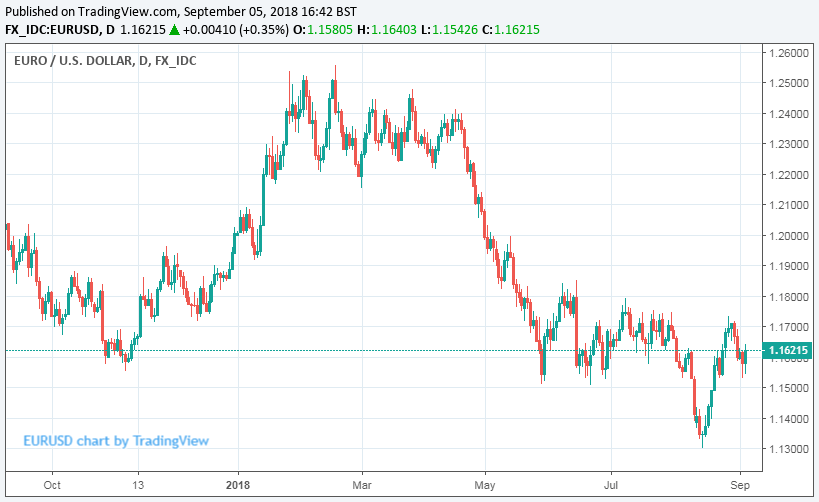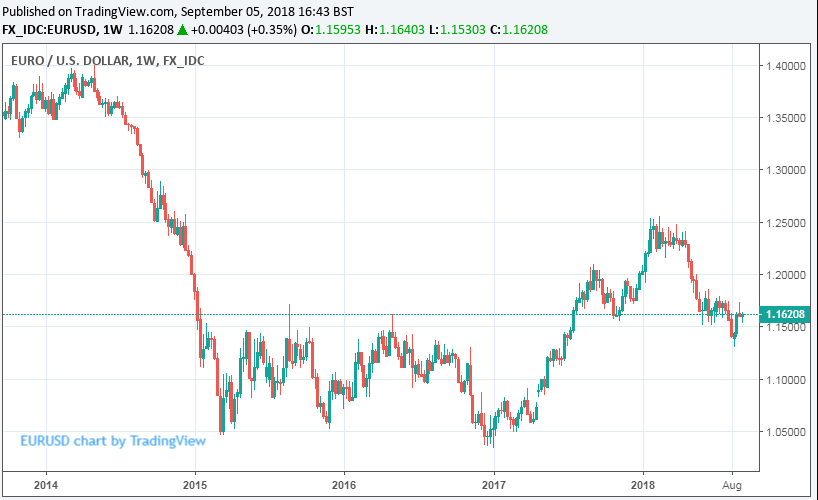Euro-to-Dollar Rate to See New Lows in September but It's a "Buying Opportunity" says Bank of America
- Written by: James Skinner
-EUR/USD to fall to 1.12 in September say Bank of America.
-Italian budget clash with Brussels to drive next trip south of 1.15.
-But this time it's a buying opportunity as recovery in cards for 2019.

Commerzbank HQ dominates the Frakfurt skyline. Image © Andre Douque, reproduced under CC licensing
The Euro-to-Dollar rate is likely to fall over coming weeks as Eurozone politics return to haunt the single currency although this time weakness in the exchange rate should be viewed as a buying opportunity by traders, according to Bank of America Merrill Lynch.
Bank of America's call comes with the Euro-to-Dollar rate trading at a 3% loss for 2018, after having reversed a 4% gain notched up during the first-quarter. But further weakness is likely to prove short-lived if the bank's currency team are right in forecasting that Italian politics won't lead to a serious renewal of fears over the longevity of the Euro.
And a weaker Dollar just might help the EUR/USD rate to recover into 2019 now the US tax-reform-induced boost to growth is waning and the greenback is up 7% for the last five months, which has left investors with a "net long" position.
"Looking ahead, after the USD rally since 1Q, it is hard to make the case for an even stronger USD now. US, Eurozone and more broadly, global data, have stabilized. EURUSD is now broadly consistent with relative data and rate differentials," says Athanasios Vamvakidis, European head of currency strategy at Bank of America.

Above: Euro-to-Dollar rate shown at daily intervals.
After gaining around 13% in 2017, the Euro went on to rise 3% against the Dollar during the first-quarter, largely due to optimism about an economic recovery in Europe and hopes the European Central Bank will soon end the post-crisis bond buying programme that has kept bond yields at record lows. This would pave the way for an eventual interest rate rise.
That trade played out against a backdrop of extreme weakness in the US Dollar, which fell 10% against a basket of its closest rivals in 2017. Quickening growth elsewhere in the world and President Trump's tax reforms, which are expected to deepen the US budget deficit and widen the US current account deficit, had left investors little incentive to hold the Dollar.
"The market is now long the USD. Although this position is not stretched, it is not supportive for a stronger USD anymore," Vamvakidis says, in recent note to clients. He estimates the US Dollar is now between 5% and 10% "overvalued".
The economic and financial drivers of this year's EUR/USD reversal were complimented in the second quarter by the political, with Italy's new coalition government having set itself on a collision course with Brussels-based budget hawks over spending pledges in its election manifesto.
Fears are that a likely Italian clash with Brussels would lead to even greater anti-Euro sentiment in Italy and potentially endanger the nation's place as a member of the single currency bloc. Both Five Star Movement (M5S) and League parties have at various points in the past advocated referendums on Italy's continued use of the Euro.
"Many investors were expecting market discipline to force the Italian government to give away their fiscal expansion plans, but high yields during the summer do not seem to have had such an effect. We believe the Italian government cares a lot about delivering on pre-election promises as they improve in the polls and are heading to the EU Parliamentary elections next May," says Vamvakidis.

Above: Euro-to-Dollar rate shown at weekly intervals.
Italy is subject to an "Excessive Deficit Procedure" for being in breach of fiscal rules set out in the Maastricht Treaty. Maastricht's Stability and Growth Pact forbids budget deficits in excess of 3% of GDP and national debt over 60% of GDP. It has until October 15 to submit its draft 2019 budget to the European Commission for approval.
Excessive deficit procedures, which were strengthened by the "Two Pack" and "Six Pack" regulations following the Eurozone debt crisis of 2011, are mandatory when either of these thresholds are breached and give the European Commission far-reaching powers to make demands of national government fiscal policies.
Italy's budget deficit fell to 2.3% of GDP during 2017, from 2.5% back in 2016, but its national debt pile of €2.4 trillion is still in excess of 130% of GDP. This means Italy is legally bound to implement Brussels' demands for action on the public finances.
But any such demands are almost certain to be at odds with the new government's policy platform of, among other things, a "basic income" for the poor, the introduction of a single flat tax rate, abandoning planned increases in VAT sales taxes and reversing earlier pension reforms.
"We now think most of the USD move has taken place. Still, Italy and the discussions of the 2019 budget this fall and trade tensions could offer one last leg to the USD rally, pushing EURUSD below 1.15 again," Vamvakidis writes. "We argue this would be an opportunity to buy the EUR dip and we forecast EURUSD at 1.20 next year."
Vamvakidis and the Bank of America currency team forecast the Euro-to-Dollar rate will fall to 1.12 before the end of September before recovering to 1.14 in time for year-end. They project a further recovery, to 1.20, in time for September 2019. The exchange rate was quoted 0.18% higher at 1.1610 during noon trading Wednesday.
Advertisement
Get up to 5% more foreign exchange by using a specialist provider to get closer to the real market rate and avoid the gaping spreads charged by your bank when providing currency. Learn more here




